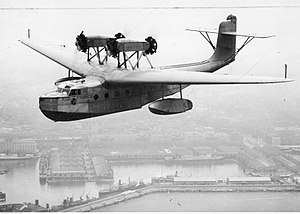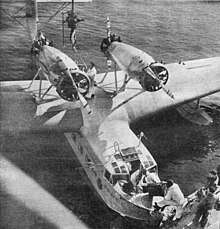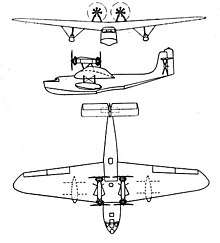Lioré et Olivier LeO H-242
The Lioré et Olivier LeO H.242 was a French-manufactured flying boat that was used for European passenger air services in the 1930s. Several were operated by Air France.
| LeO H.242 | |
|---|---|
 | |
| Role | Passenger flying boat |
| National origin | France |
| Manufacturer | Lioré et Olivier |
| First flight | 1929 |
| Introduction | 1933 |
| Retired | 1942 |
| Primary user | Air France |
| Number built | 15 |
One LeO H.242 features at the end of Hergé's The Adventures of Tintin comic King Ottokar's Sceptre.[1]

An Air France LeO H-242 at Marseille
Variants
- H-24.01
- First prototype. Powered by two 373 kW (500 hp) Renault 12Jb engines. One built.
- H-241
- The initial four-engined long-range heavy-weight variant of the H-24. The hull was almost exclusively made of anodised Duralumin, for corrosion resistance. Although construction began before the H.242, the sole H.241 was completed later, but did not enter production.[2]
- H-242
- Initial production. Powered by four Gnome-Rhône 7Kd Titan Major radial engines. Two were built for Air France and delivered in December 1933 and February 1934. They could carry ten passengers.[3]
- H-242/1
- Revised production version, with a modified engine installation. Twelve were built for Air France and delivered between March 1935 and May 1937, carrying twelve passengers. Most H.242/1s were fitted with wide chord NACA cowlings over the front engine only, but some aircraft were fitted with narrow chord Townend rings around the front engine.[2]
- H-243
- an un-built projected version for the French navy with enlarged hull.[2]
- H-244
- A projected high-speed inter-continental flying boat for Air Union, abandoned when Air Union was absorbed by Air France.[2]
- H-246
- A major redesign, the four engines now all in tractor configuration.
Specifications (H-242/1)

LeO H.242 3-view drawing from L'Aerophile July 1934
Data from The Encyclopedia of World Aircraft [4], [5]
General characteristics
- Crew: 4
- Capacity: 12 passengers
- Length: 18.45 m (60 ft 6 in)
- Wingspan: 28 m (91 ft 10 in)
- Height: 6.33 m (20 ft 9 in)
- Wing area: 116.25 m2 (1,251.3 sq ft)
- Empty weight: 5,868 kg (12,937 lb)
- Max takeoff weight: 8,700 kg (19,180 lb)
- Powerplant: 4 × Gnome-Rhône 7Kd Titan Major 7-cylinder air-cooled radial piston engines, 261 kW (350 hp) each
- Propellers: 2-bladed variable-pitch propellers
Performance
- Maximum speed: 240 km/h (150 mph, 130 kn)
- Range: 1,100 km (680 mi, 590 nmi)
- Service ceiling: 4,500 m (14,800 ft)
- Time to altitude: 1,000 m (3,281 ft) in 6 minutes 50 seconds
gollark: <@!509849474647064576> Initiate contingency γ/5.
gollark: It isn't? Oh bee oh apiobeeobeeoid.
gollark: No const generics and it just goes up to 32.
gollark: If FnTwice, then by induction FnThrice.
gollark: It's certainly possible.
See also
References
| Wikimedia Commons has media related to Lioré et Olivier LeO H-242. |
- .
- Hartmann, Gérard. "Le Lioré et Olivier H-24, premier hydravion d'Air France" (in French). Missing or empty
|url=(help) - "Nico Braas Collection". 1000aircraftphotos.com. Retrieved 17 April 2015.
- Donald 1997, p.568.
- Parmentier, Bruno (19 January 2010). "Aviafrance : Lioré et Olivier LeO H-242/1". Aviafrance (in French). Retrieved 8 November 2019.
- Donald, David (editor).The Encyclopedia of World Aircraft. Leicester, UK:Blitz, 1997. ISBN 1-85605-375-X.
This article is issued from Wikipedia. The text is licensed under Creative Commons - Attribution - Sharealike. Additional terms may apply for the media files.